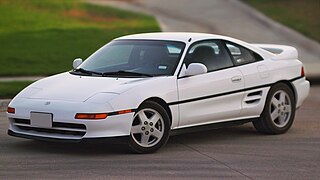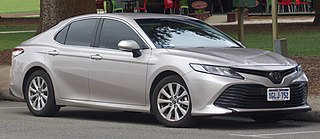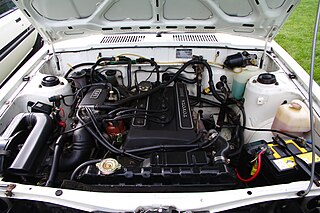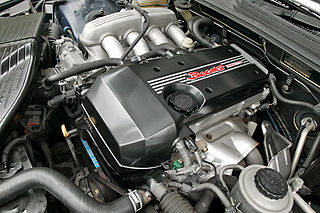
The Toyota Celica is an automobile produced by Toyota from 1970 until 2006. The Celica name derives from the Latin word coelica meaning heavenly or celestial. In Japan, the Celica was exclusive to Toyota Corolla Store dealer chain. Produced across seven generations, the Celica was powered by various four-cylinder engines, and body styles included convertibles, liftbacks, and notchback coupé.

The Toyota Supra is a sports car and grand tourer manufactured by the Toyota Motor Corporation beginning in 1978. The name "supra" is derived from the Latin prefix, meaning "above", "to surpass" or "go beyond".

The Toyota MR2 is a line of two-seater, mid-engined, rear-wheel-drive sports cars, manufactured in Japan and marketed globally by Toyota from 1984 until 2007 over three generations: W10 (1984–1989), W20 (1989–1999) and W30 (1999–2007). It is Japan's first rear mid-engined production car.

The Toyota Camry is an automobile sold internationally by the Japanese auto manufacturer Toyota since 1982, spanning multiple generations. Originally compact in size (narrow-body), the Camry has grown since the 1990s to fit the mid-size classification (wide-body)—although the two widths co-existed in that decade. Since the release of the wide-bodied versions, Camry has been extolled by Toyota as the firm's second "world car" after the Corolla. As of 2022, the Camry is positioned above the Corolla and below the Avalon or Crown in several markets.

The Toyota Chaser is a mid-size car produced by Toyota. In the beginning, Chasers were four-door sedans and hardtop sedans; a two-door coupé was available only for the first generation. It was introduced on the Toyota Mark II (X30) platform and was only available at Japanese Toyota Auto Store dealerships as their top-level model. The Chaser was produced for six generations; production ceased in 2001 when both it and the Cresta were replaced by the short-lived Verossa.

The Toyota R family was a series of inline-four gasoline automobile engines. Designed for longitudinal placement in such vehicles as the Celica and Hilux and in production from 1953 through 1997, usage faded out as many of Toyota's mainstream models moved to front-wheel drive. Overhead cam (OHC) versions featured a chain-driven camshaft.

The Toyota T series is a family of inline-4 automobile engines manufactured by Toyota beginning in 1970 and ending in 1985. It started as a pushrod overhead valve (OHV) design and later performance oriented twin cam (DOHC) variants were added to the lineup. Toyota had built its solid reputation on the reliability of these engines.

All American Racers is an American-licensed auto racing team and constructor based in Santa Ana, California. Founded by Dan Gurney and Carroll Shelby in 1964, All American Racers initially participated in American sports car and Champ Car races as well as international Formula One events with cars named Eagle. The Formula One team, based in the United Kingdom and using British-built Weslake engines was named Anglo American Racers. Under team manager Bill Dunne they set up shop in Rye, East Sussex. The team were adjacent to Harry Weslake's engine development plant and half a mile from Elva cars. They participated in 25 Grands Prix, entering a total of 34 cars.

The Toyota Carina is an automobile which was manufactured by Toyota from December 1970 to December 2001. It was introduced as a sedan counterpart of the Celica, with which it originally shared a platform. Later, it was realigned to the Corona platform, but retained its performance image, with distinctive bodywork and interior — aimed at the youth market and remaining exclusive to Japanese Toyota dealerships Toyota Store. It was replaced in Japan by the Toyota Allion in 2001 and succeeded in Europe by the Toyota Avensis.

The Toyota Caldina is an automobile manufactured by Toyota for the Japanese market from 1992 to 2007. It replaced the Corona and Carina wagons, and was sold at Toyota Store and Toyopet Store locations in Japan. While the Caldina has never been officially exported by Toyota, its All-Trac 4WD capability and large capacity have made it a popular grey import in Australia, New Zealand, Russia and many South American countries. When it was discontinued in 2007, the T270 series Avensis wagon/estate assumed its market position.

The Toyota S Series engines are a family of straight-four petrol engines with displacements between 1.8 and 2.2 litres, produced by Toyota Motor Corporation from January 1980 to August 2007. The S series has cast iron engine blocks and aluminium cylinder heads. This engine was designed around the new LASRE technology for lighter weight – such as sintered hollow camshafts.

Per Torsten Eklund is a Swedish Rally and Rallycross driver. His nickname is "Pekka". In rallying he never made it to the very top but he has been very successful in his later rallycross career.

Calty Design Research Incorporated is a Toyota design studio established in 1973. They have two facilities: one in Newport Beach, California for concept designs, and another in Ann Arbor, Michigan for production designs. Calty provides both interior and exterior styling proposals for future Toyota vehicles and advanced design, production color and wheel design concepts for Toyota's product development operations.

The Toyota Celica GT-Four is a high performance model of the Celica Liftback that was produced from 1986 to 1999, with a turbocharged 3S-GTE engine, and full-time AWD. It was created to compete in the World Rally Championship, whose regulations dictate that a manufacturer must build road-going versions of the vehicle in sufficient numbers. These vehicles are referred to as "homologation special vehicles".

IMSA GT was a sports car racing series organized by International Motor Sports Association. Races took place primarily in the United States and occasionally in Canada.

During its history the Toyota Supra has enjoyed considerable success in a variety of different motorsports.
The Toyota Celica Liftback Turbo was a Group 5 Special Production racecar version of the 3-door liftback first generation Toyota Celica GT built by Schnitzer via Toyota Deutschland to compete in Division 1 of the DRM.

Toyota vehicles in Japan are distributed to numerous dealership chains throughout the country. Up to May 2020, each dealership chain had a different product offering, with some models restricted to one chain to maintain exclusivity. Since May 2020, every Toyota model in Japan was available in all dealership chains. Current dealership chains include Toyota Store, Toyopet Store, Toyota Corolla Store and Netz Store.
















